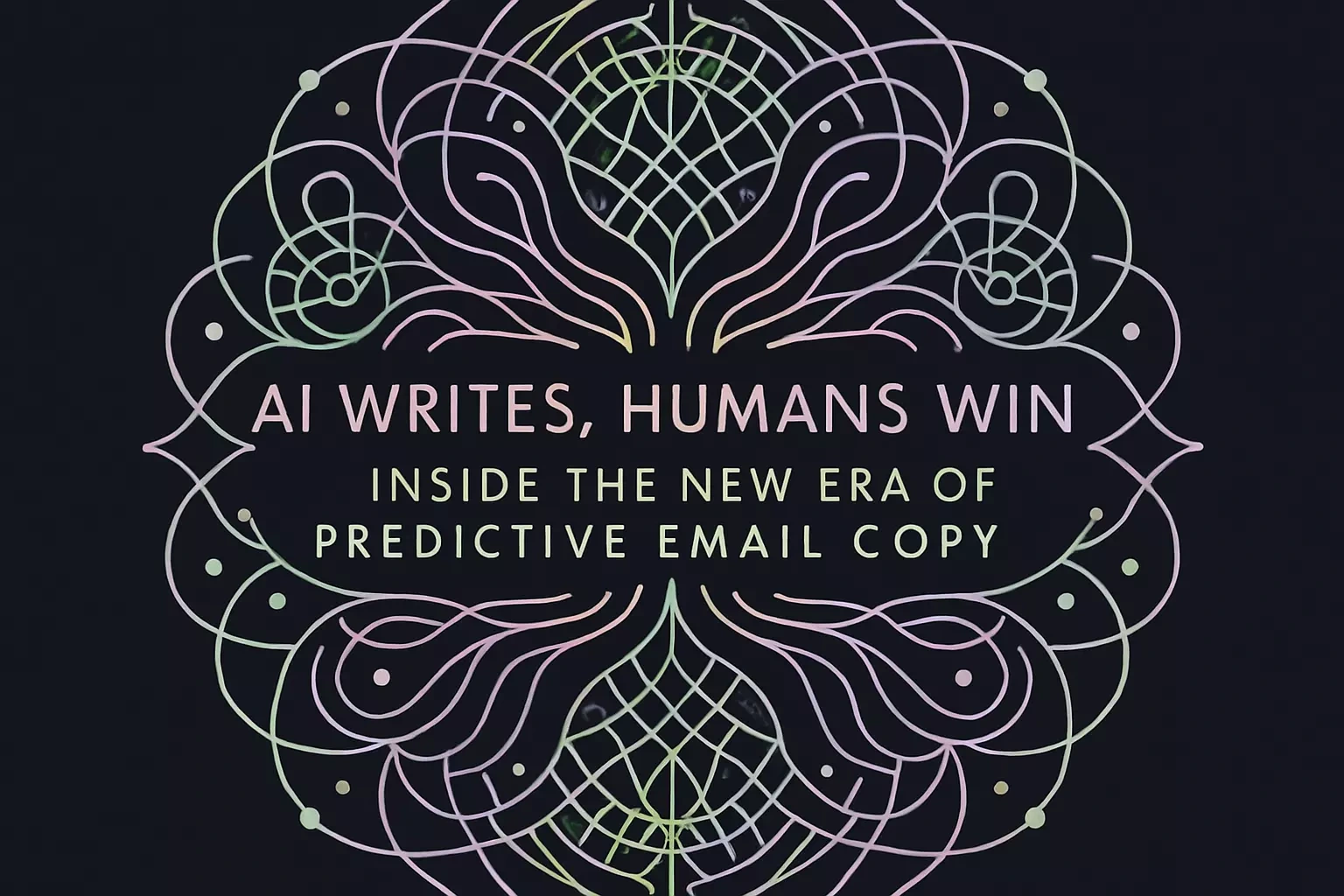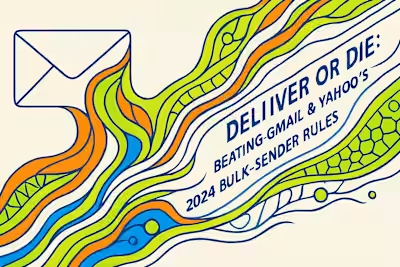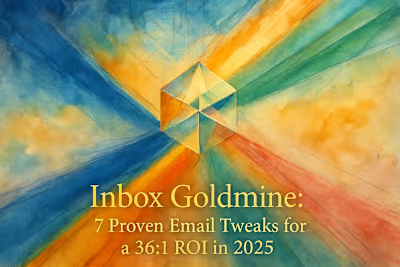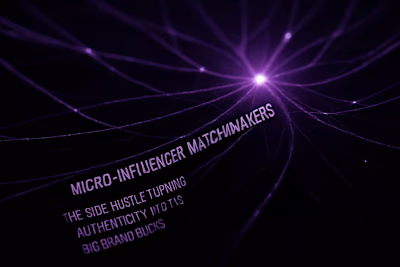AI Writes, Humans Win: Inside the New Era of Predictive Email Copy

AI Writes, Humans Win: Inside the New Era of Predictive Email Copy
The Power of Predictive Personalization
Predicting Customer Behavior
Optimizing Send Times with AI
Generative AI for High-Converting Copy
Crafting AI-Powered Subject Lines
Dynamic Content Generation
The Human Element: Where Marketers Add Value
Strategic Campaign Planning
Ensuring Brand Voice and Empathy
Measuring the Impact of AI in Email Marketing
Key Performance Indicators (KPIs) to Track
The Future of AI and Email
References
AI Writes, Humans Win: Inside the New Era of Predictive Email Copy
Email marketing just got a serious upgrade. AI isn't some far-off dream anymore – it's here, analyzing mountains of data to predict what your customers want before they even know it themselves. This powerful technology personalizes content for thousands of people at once and fine-tunes campaigns while you sleep. But here's the thing: AI handles the grunt work so you can focus on what really matters – strategy and creative thinking.
If you're looking to hire email marketers who understand this new landscape, you'll want people who can work alongside AI, not against it. The best marketers today know how to blend machine intelligence with human insight. They understand that while AI can crunch numbers and generate content, it takes a human touch to craft messages that truly connect. Speaking of connection, we'll explore simple tweaks for a better ROI that work whether you're using AI or not. Plus, we'll dive into the exciting world of gamified emails that turn boring newsletters into interactive experiences.
The Power of Predictive Personalization
Remember when personalization meant adding someone's first name to an email? Those days are long gone. Today's AI predictive personalization is like having a crystal ball for each customer. It watches patterns, learns preferences, and anticipates needs before customers even realize what they want.
Think about Netflix recommending your next binge-watch before you finish your current series. That's the kind of predictive power we're talking about, but for your inbox. AI analyzes past behavior to forecast future actions, letting brands send exactly the right content at exactly the right moment. No more spray-and-pray campaigns – this is precision marketing at its finest.
Predicting Customer Behavior
Here's where things get really interesting. AI algorithms dig through historical data like digital detectives. They spot patterns humans would miss in a million years. Which customers are ready to buy? Who's thinking about jumping ship? What product will Sarah from Seattle want next after buying those running shoes?
The AI knows. It tracks purchase history, browsing behavior, email engagement, and dozens of other signals. Then it builds a profile for each customer that's constantly updating. When John opens emails on Tuesday mornings but ignores weekend messages, the AI notices. When Maria always clicks on sale items but never full-price products, the AI remembers.
This lets you create campaigns that feel almost psychic. Send a "we miss you" discount to customers showing signs of leaving. Recommend complementary products right when buyers are most likely to want them. Target heavy users with loyalty rewards before they even think about switching brands. It's proactive marketing that makes customers feel understood, not stalked.
Optimizing Send Times with AI
Forget about those generic "best time to send emails" articles. AI takes timing to a whole new level. Instead of blasting everyone at 10 AM on Tuesday, AI figures out when each individual person actually reads their emails.
Maybe Tom checks email during his morning commute at 7:15 AM. Lisa scrolls through messages during her lunch break. Ahmed catches up on emails after putting the kids to bed. AI tracks these patterns and adjusts accordingly. It's like having a personal assistant who knows exactly when to tap each customer on the shoulder.
This isn't just about time zones anymore. It's about lifestyle patterns. The AI might notice that college students engage more on Sunday nights while working professionals prefer Wednesday afternoons. Parents might open emails during school pickup time. Night shift workers have completely different schedules. The system adapts to each person's rhythm, boosting open rates significantly.
Generative AI for High-Converting Copy
Writers, don't panic – AI isn't here to steal your job. It's here to make it easier. Right now, 34% of marketers use generative AI to write email copy. These tools pump out subject lines, body content, and calls-to-action faster than any human could. But speed isn't the only advantage.
AI can generate dozens of variations for A/B testing. It learns what works with different audience segments. Young professionals might respond to casual, emoji-filled subject lines. Corporate executives might prefer formal, benefit-focused language. The AI adjusts its writing style based on what gets results.
But here's the key: AI-generated copy is a starting point, not a finish line. The best results come when humans and machines work together. AI handles the heavy lifting of creating multiple versions and analyzing performance data. Humans add the creativity, emotion, and brand personality that makes messages memorable.
Crafting AI-Powered Subject Lines
Subject lines make or break your email campaign. Get it wrong, and your carefully crafted message goes straight to trash. Get it right, and you've got their attention. AI analyzes thousands of successful subject lines to understand what makes people click.
Using AI for subject line optimization can boost open rates by up to 10%. That might not sound huge, but when you're sending millions of emails, those percentage points add up fast. The AI considers factors like length, word choice, emoji usage, personalization, and urgency. It knows that "Last chance!" works better on Friday than Monday. It understands that questions often outperform statements.
The real magic happens when AI tailors subject lines to individual preferences. Some people love puns and wordplay. Others want straight facts. Some respond to FOMO (fear of missing out) while others prefer exclusive offers. The AI tracks what works for each person and adjusts accordingly. It's like having a copywriter who knows every customer personally.
Dynamic Content Generation
Static emails are so 2010. Today's AI creates emails that change based on who's reading them. Product recommendations shift based on browsing history. Blog post suggestions match recent interests. Special offers align with purchase patterns. Every email becomes a personalized experience.
Imagine sending one email campaign that looks completely different to each recipient. The fashion lover sees trending styles and outfit ideas. The tech enthusiast gets gadget reviews and early access deals. The fitness buff receives workout tips and protein powder discounts. Same campaign, totally different content.
This dynamic approach extends beyond products. AI can adjust tone, length, and complexity based on engagement patterns. Readers who typically skim get bullet points and bold headlines. Those who read every word receive detailed explanations. Visual learners see more images while text lovers get in-depth articles. It's personalization that goes way deeper than "Hi [First Name]."
The Human Element: Where Marketers Add Value
Let's be real – AI is amazing at crunching numbers and spotting patterns. But it doesn't understand why your brand exists or what makes your customers tick on an emotional level. That's where human marketers become irreplaceable.
Think of AI as your incredibly smart assistant who never sleeps. It handles the data analysis, generates content variations, and optimizes send times. But you're still the boss. You set the strategy, define the goals, and make sure everything aligns with your brand's bigger picture. AI might write the words, but humans provide the soul.
Strategic Campaign Planning
Before AI writes a single word, someone needs to answer the big questions. What are we trying to achieve? Who are we talking to? What story are we telling? These strategic decisions require human insight, creativity, and understanding of market dynamics that AI can't replicate.
Marketers must map out the customer journey, identifying key touchpoints where email can make a difference. They decide whether to focus on acquisition or retention. They choose between educational content or promotional offers. They determine how email fits with other marketing channels. These strategic choices shape everything that follows.
AI excels at execution, but strategy requires human judgment. You need to understand competitive landscapes, interpret cultural trends, and anticipate market shifts. You must balance short-term gains with long-term brand building. These nuanced decisions demand experience, intuition, and creative thinking that only humans possess.
Ensuring Brand Voice and Empathy
Your brand voice is like your personality – it's what makes you unique and memorable. AI can mimic writing styles, but maintaining authentic brand voice requires human oversight. Every piece of content needs to feel like it comes from the same company, whether written by human or machine.
More importantly, real empathy comes from humans. When customers face challenges, celebrate milestones, or need support, they want to feel understood. AI can identify these moments through data patterns, but crafting genuinely empathetic responses requires human touch. It's the difference between "We notice you haven't purchased recently" and "We miss you! Everything okay?"
Marketers must review AI output to ensure it strikes the right emotional tone. They add personality quirks that make brands memorable. They catch cultural references AI might miss or misuse. They ensure humor lands properly and sensitive topics get appropriate treatment. This human filter transforms competent AI copy into compelling brand communication.
Measuring the Impact of AI in Email Marketing
Numbers don't lie – AI is transforming email marketing results. Companies using AI-driven campaigns report significant improvements across all key metrics. But measuring success requires looking beyond basic open rates to understand the full impact.
The real test comes from comparing AI-powered campaigns to traditional approaches. Smart marketers run parallel tests, sending AI-optimized emails to one segment while maintaining standard practices for another. The differences often surprise even seasoned professionals. Higher engagement, better conversion rates, and increased revenue become the norm, not the exception.
Key Performance Indicators (KPIs) to Track
Start with the basics: open rates, click-through rates, and conversion rates. But don't stop there. AI's true value shows up in deeper metrics. Track revenue per email to see financial impact. Monitor list growth rates to measure long-term health. Watch unsubscribe rates to ensure personalization isn't becoming creepy.
Studies show AI-driven emails achieve a 13% increase in click-through rates compared to traditional campaigns. But individual results vary widely. Some brands see 20-30% improvements while others gain modest single-digit increases. The difference often comes down to data quality and implementation strategy.
Advanced metrics to monitor:
Customer lifetime value changes
Email engagement over time
Cross-channel attribution
Segment performance variations
Content preference patterns
Pay special attention to engagement trends. Are customers opening more emails over time? Do they click through to your website more often? These behavioral shifts indicate whether AI personalization is building stronger relationships or just achieving short-term wins.
The Future of AI and Email
The AI revolution in email marketing is just getting started. Today's tools will seem primitive compared to what's coming. Marketers predict hyper-personalization will become the norm, with every aspect of email communication tailored to individual preferences.
Future AI will understand context better. It'll know when customers are traveling, starting new jobs, or experiencing life changes. It'll adjust messaging accordingly, offering relevant products and services at perfect moments. Imagine emails that adapt to your mood, detected through interaction patterns and response timing.
Integration with other technologies will deepen. Voice assistants will read AI-optimized emails aloud. Augmented reality will let customers try products virtually within emails. Blockchain might verify sender authenticity and prevent phishing. The email of 2030 will be an interactive, intelligent experience far beyond today's static messages.
But one thing won't change: the need for human creativity and strategic thinking. As AI handles more tactical execution, marketers must level up their strategic skills. Understanding customer psychology, crafting compelling narratives, and building authentic relationships will become even more valuable. The future belongs to marketers who embrace AI as a powerful tool while maintaining their uniquely human strengths.
References
Like this project
Posted Jun 17, 2025
AI is transforming email marketing. Learn how predictive personalization and AI-generated content can boost open rates, CTR, and conversions while saving you time.







